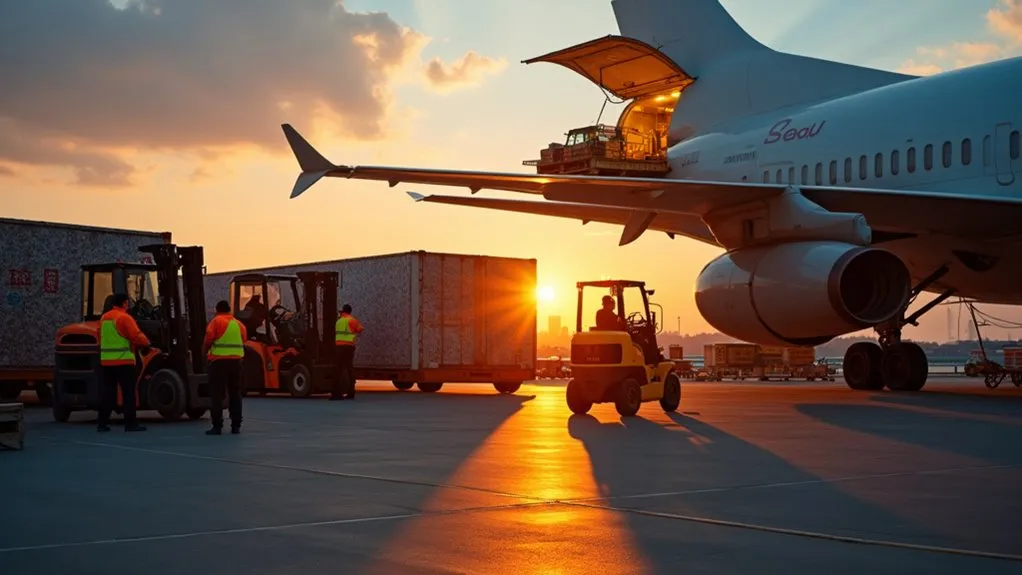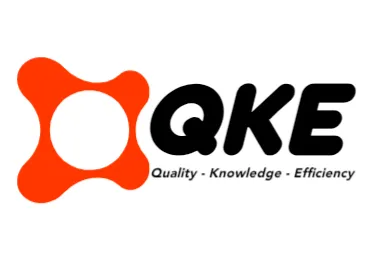Mastering air cargo track and trace involves ten key steps. Start by understanding the Air Waybill (AWB) for tracking. Use GPS, RFID, and IoT for real-time visibility. Follow core processes from AWB issuance to delivery. Recognize benefits like cost savings. Tackle challenges like data silos. Ensure accurate data entry. Integrate systems for seamless updates. Leverage analytics for insights. Prioritize shipment visibility. Explore further to uncover detailed strategies for optimizing air cargo logistics efficiency.
Key Takeaways
- Use an Air Waybill (AWB) with its 11-digit number for accurate cargo tracking.
- Implement GPS and IoT sensors for real-time location and condition monitoring.
- Integrate platforms using API for unified, real-time data across carriers.
- Adopt e-AWBs to reduce manual errors and enhance documentation efficiency.
- Leverage AI analytics for route optimization and proactive delay management.
Grasp the Basics of Air Cargo Tracking

How does one ensure the seamless movement of goods across the globe via air freight? Understanding the Basic Concepts of air cargo tracking is paramount. This process involves monitoring shipments from origin to destination, providing real-time updates on location, status, and estimated arrival times. It fosters transparency and accountability among stakeholders like shippers, carriers, and consignees, ensuring logistics efficiency and meeting supply chain demands.
Central to this are Key Definitions, such as the Air Waybill (AWB), a critical document and tracking tool with a unique 11-digit number. Issued by shippers or carriers, the AWB contains vital shipment details and enables tracking via airline platforms. The core process includes AWB issuance, cargo scanning at acceptance, in-transit updates at checkpoints, and delivery confirmation. This visibility aids planning, enhances customer trust, and supports prompt issue resolution, ultimately reducing costs and optimizing air freight operations. Additionally, it’s important to note that access to tracking platforms may sometimes be restricted due to security measures implemented by service providers like Cloudflare to protect against attacks.
Leverage Cutting-Edge Tracking Technologies
Air cargo operators can significantly enhance tracking capabilities by adopting GPS solutions, which provide precise real-time location data for shipments across global routes. Implementing IoT sensors further strengthens monitoring by capturing critical condition metrics like temperature and humidity, essential for sensitive cargo. Additionally, utilizing blockchain security ensures a tamper-proof ledger for documentation and shipment tracking, fostering trust and efficiency among supply chain partners.
Adopt GPS Solutions
Embracing GPS solutions marks a transformative step for air cargo tracking, offering unparalleled precision in monitoring shipments across the globe. These systems utilize satellite signals for real-time location data, enhancing supply chain visibility and enabling proactive decisions. They bolster security by tracking high-value cargo, deter theft, and support recovery with auditable location logs.
Operationally, GPS optimizes routes, reduces transit times, and minimizes losses, while improving customer trust through transparent updates. However, compliance with aviation regulations like EASA and FAA is critical for device safety.
| Benefit | Impact |
|---|---|
| Real-Time Visibility | Instant cargo location updates |
| Enhanced Security | Theft deterrence and recovery |
| Reduces operational costs | |
| Route Optimization | Minimizes transit delays |
| Customer Satisfaction | Builds trust with timely updates |
Implement IoT Sensors
Building on the precision of GPS solutions, logistics providers can further enhance air cargo tracking by implementing IoT sensors. These devices offer real-time monitoring of location, temperature, humidity, and shock, transmitting critical data via gateways to cloud platforms for analysis. Proper Sensor Calibration ensures accuracy in detecting environmental deviations, enabling timely alerts for issues like temperature excursions.
Moreover, IoT sensors improve operational efficiency by automating data collection and optimizing routes. However, challenges like integration with legacy systems and connectivity in remote areas must be addressed. Effective Power Management is vital to extend sensor battery life, minimizing maintenance needs. By leveraging these technologies, logistics firms gain transparency, enhance security, and deliver superior customer service through actionable insights.
Utilize Blockchain Security
Leveraging blockchain technology offers a transformative approach to securing air cargo track and trace systems. By employing decentralized ledgers, it ensures data integrity through Cryptographic Hashing, making tampering nearly impossible. Consensus Mechanisms guarantee that alterations require network-wide agreement, enhancing trust among stakeholders. This technology provides real-time visibility, streamlines processes via smart contracts, and fortifies security protocols.
Below is a snapshot of blockchain benefits for air cargo:
| Feature | Benefit |
|---|---|
| Decentralization | Reduces single-point failure risks |
| Immutability | Ensures tamper-proof data history |
| Transparency | Builds trust with shared visibility |
| Security | Protects data with advanced encryption |
Ultimately, blockchain optimizes efficiency, minimizes fraud, and fosters collaboration across the air cargo ecosystem with unparalleled security.
Follow the Core Tracking Process
Navigating the air cargo tracking process requires a clear understanding of its structured stages, ensuring shipments are monitored with precision from origin to destination. The journey begins with the Air Waybill (AWB), a critical document with a unique 11-digit number, serving as a contract and tracking tool. Shippers must ensure accurate AWB details match labels and invoices for seamless routing.
Upon shipment acceptance, airlines or forwarders verify AWB data and scan barcodes to enter cargo into tracking systems. Advanced technologies like RFID tags and IoT devices capture real-time location and condition data at key checkpoints. Status updates at milestones, such as Freight Into Warehouse (FIW), provide visibility via integrated carrier systems. Stakeholders access detailed timelines and notifications through platforms using the AWB number. Finally, delivery confirmation occurs post-customs clearance, ensuring all parties are informed of cargo collection, maintaining efficiency throughout the process.
Recognize the Advantages of Robust Tracking

How does robust tracking transform air cargo operations? It revolutionizes efficiency through real-time data, enabling swift decisions and proactive delay management, while AI-driven analytics optimize load planning to cut waste and costs. Visibility platforms, leveraging GPS and IoT, offer stakeholders precise shipment status from origin to destination, eliminating guesswork and enhancing transparency.
Beyond operations, robust tracking boosts customer trust with accurate updates and proactive communication, strengthening reputation. It also drives cost savings by optimizing routes and resources, positively influencing Environmental Impact through reduced fuel consumption. Security is fortified with real-time condition monitoring, ensuring cargo integrity and compliance. Finally, it provides Market Differentiation, as companies offering superior tracking stand out in a competitive landscape, attracting clients seeking reliability and transparency. These advantages collectively elevate operational standards, minimize risks, and position firms as leaders in the air cargo industry through innovative tracking solutions.
Address Common Tracking Obstacles
What challenges persist in air cargo tracking despite technological advancements? Despite progress, air cargo tracking faces significant hurdles like data fragmentation across multiple stakeholders using disparate systems, leading to errors and delays from manual processes. Real-time visibility remains limited, with delayed updates and inaccurate ETAs complicating multi-modal tracking and increasing risks of lost shipments. Technology adoption is hindered by high costs and integration complexities with legacy systems, while cybersecurity concerns add further barriers to centralized data platforms.
Process inefficiencies, such as manual documentation and miscommunications during Vendor Coordination, exacerbate delays and operational costs. Additionally, poor visibility into disruptions like weather or customs delays necessitates thorough Risk Assessment to mitigate incidental costs and improve contingency planning. Addressing these obstacles requires tackling data gaps, enhancing transparency, and overcoming integration challenges to ensure smoother tracking across the supply chain, ultimately reducing risks and improving reliability for all parties involved.
Implement Best Practices for Efficiency

Why settle for inefficiencies when air cargo tracking can be transformed through strategic best practices? By leveraging advanced technologies like GPS, RFID, and IoT sensors, companies can achieve real-time visibility and monitor cargo conditions with smart sensors. Integrating platforms for a unified view across carriers optimizes oversight, while AI-driven analytics enhance load planning and route optimization, maximizing space and reducing costs.
Focusing on ULD Efficiency, implementing Bluetooth tags for real-time tracking and integrating data with e-AWBs ensures precise monitoring of roughly 900,000 global units, minimizing losses. Collapsible ULDs further boost storage capacity and sustainability. Meanwhile, Collaboration Strategies are vital—utilizing Airport Cargo Community Systems and digital platforms enables seamless data sharing among stakeholders. Building strong relationships with carriers and forwarders secures capacity and tailored services. These practices, rooted in automation and predictive tools, streamline operations and elevate air cargo tracking to new heights of efficiency.
Prioritize Accurate Data Entry

Accurate data entry stands as the bedrock of efficient air cargo operations, ensuring that every shipment detail, from weight to pricing, is correctly reflected. Without precision, confusion and delays arise, risking costly compliance breaches and strained client relations. High-quality data—accurate, timely, and complete—enhances supply chain efficiency, accelerates clearance, and supports reliable decision-making.
To achieve this, organizations must prioritize rigorous Entry Training for staff, equipping them with skills to input data meticulously and double-check critical details like air waybills. Implementing Accuracy Auditing processes further ensures consistency and identifies errors before they escalate into operational setbacks. Digitizing documentation, such as adopting e-AWBs, minimizes manual mistakes, while clear communication with carriers maintains data relevance. The benefits are undeniable: reduced costs, improved security, and maximized consistency across the supply chain. By focusing on precision, air cargo stakeholders can prevent customs delays and uphold operational excellence.
Integrate Systems for Seamless Updates

Building on the foundation of precise data entry, air cargo operations must also focus on integrating systems to ensure seamless updates across the supply chain. Effective integration hinges on leveraging API Integration to enable real-time data exchange between disparate platforms like airlines and tracking systems, minimizing latency and automating processes. Equally critical is Data Standardization, which ensures interoperability through models like IATA’s ONE Record, breaking down silos for unified shipment visibility.
Key aspects of system integration include:
- Real-Time Connectivity: API Integration facilitates instant updates on cargo status and location.
- Unified Data Models: Data Standardization ensures consistent information sharing across stakeholders.
- Operational Efficiency: Integrated systems automate manual tasks, reducing errors and delays.
- Enhanced Visibility: Seamless updates provide end-to-end tracking for better decision-making.
Utilize Analytics for Strategic Insights

How can air cargo operations transform raw data into actionable strategies? By leveraging Data Analytics, companies can convert vast amounts of information into precise, impactful decisions. Predictive tools analyze historical and real-time data to anticipate demand patterns, forecast disruptions like weather delays, and enable proactive risk mitigation. This approach supports Strategic Forecasting, ensuring optimized resource allocation and tailored shipping solutions.
Furthermore, analytics enhance operational efficiency by identifying bottlenecks in flight schedules and routing, optimizing load planning, and reducing fuel costs through detailed data insights. Performance monitoring via Key Performance Indicators allows firms to track on-time delivery and dwell times, driving continuous improvement. Market intelligence, derived from trend analysis, aids in dynamic pricing and identifying service gaps. Ultimately, Data Analytics empowers air cargo operations with Strategic Forecasting to refine processes, boost revenue, and elevate customer satisfaction through informed, data-driven strategies.
Ensure Comprehensive Shipment Visibility

Precision in air cargo operations hinges on ensuring comprehensive shipment visibility across every stage of the journey. This involves leveraging advanced technology like GPS, RFID, and IoT sensors to provide real-time updates on location and conditions, while integrating data through API/EDI for a unified view on centralized platforms. Such visibility extends beyond checkpoints, covering multimodal transport and ground handling, ensuring a single source of truth for all stakeholders.
Comprehensive shipment visibility in air cargo operations is vital, using GPS, RFID, and IoT for real-time updates and a unified stakeholder view.
To achieve this, consider the following strategies:
- Deploy IoT Devices: Use sensors for granular data on temperature, humidity, and shock during transit.
- Enhance Staff Education: Train teams to interpret tracking data and respond to alerts effectively.
- Strengthen Partnership Alliances: Collaborate with carriers and logistics providers for seamless data sharing.
- Monitor Milestones: Automate tracking of critical events like customs clearance and delivery.
These steps ensure transparency, security, and compliance, mitigating risks and optimizing air cargo operations.

 Tiếng Việt
Tiếng Việt 日本語
日本語 中文 (中国)
中文 (中国) 한국어
한국어